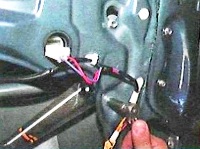Regularly check the condition of the steering, as driving safety depends on it
When inspecting the steering, pay special attention to the condition of the protective covers and threaded connections
Be sure to replace rubber boots that are torn, cracked or have lost elasticity, otherwise water, dust and dirt that get into the nodes will quickly disable them.
Check the position of the steering wheel spokes, which, when the front wheels are in a straight position, should be located symmetrically about the vertical axis.
If not, determine the cause of the problem and fix it.
Turning the steering wheel from lock to lock, check visually and aurally:
- - reliability of fastening of the steering mechanism and steering wheel;
- - absence of backlash in the steering rod joints and ball joints of the tie rod ends;
- - no jamming and interference preventing the steering wheel from turning.
If you find knocking or sticking, disconnect the tie rods from the steering knuckle arms and retest.
If the knocking and binding continues, remove the steering gear from the vehicle and have it repaired.

Check the condition of the protective covers of the tie rod ends
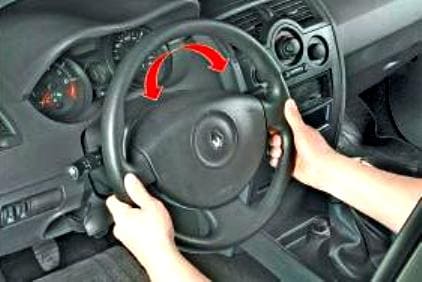
By turning the steering wheel sharply in both directions (this should be done by an assistant), visually and aurally check the steering gear mounting.
Movement of the mechanism and knocks are not allowed.
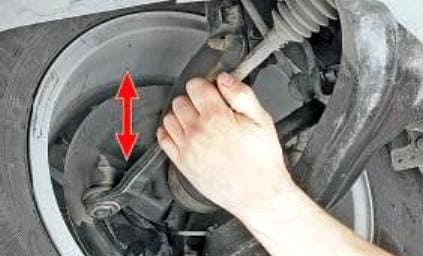
Check for play in the tie rod ends.
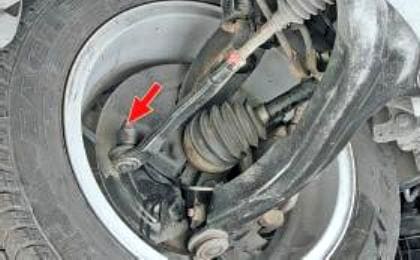
Replace the tips, the hinges of which have a noticeable play.
Check the tightness of the tie rod pin nuts
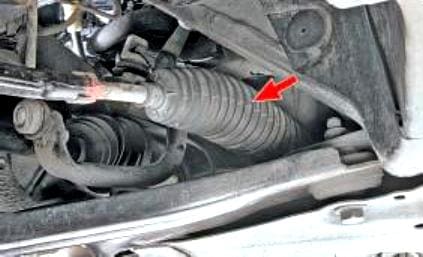
Check the condition of the protective covers of the steering rods
Be sure to replace damaged covers.
Checking the free play (backlash) of the steering wheel
With an increased free play of the steering wheel, it is difficult to control the car, as it responds to the driver's actions with a delay.
In addition, an increased stroke that cannot be eliminated by adjusting the steering mechanism indicates a steering malfunction (loosening of the steering mechanism, steering rods or wear of their parts).
The play must not exceed 5°.
You can also determine the backlash in linear units (mm) using the formula:
L = (5˚/360˚)pD
- where L — steering wheel play, mm; p = 3.14; D - outer diameter of the steering wheel, mm.
You will need: ruler, caliper, chalk (or wire) for marking.
Check the steering wheel play with the vehicle parked on a level, non-slip surface.
Set the front wheels in a straight ahead position.
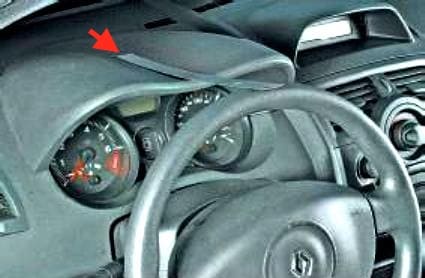
Attach the ruler to the dashboard so that its end touches the outer surface of the steering wheel rim.
Without changing the position of the ruler, turn the steering wheel to the right until the front wheels begin to turn.
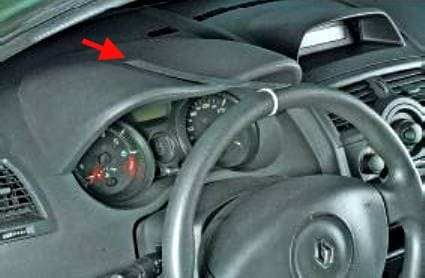
In this position, mark the steering wheel rim (fasten the wire).
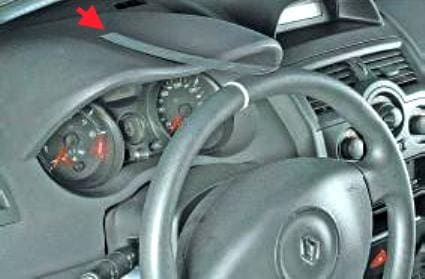
Without changing the position of the ruler, turn the steering wheel to the left until the front wheels begin to turn.
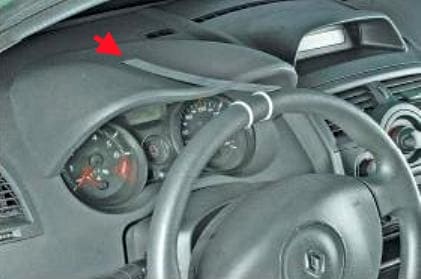
In this position, put a second mark on the steering wheel rim (fasten the wire).
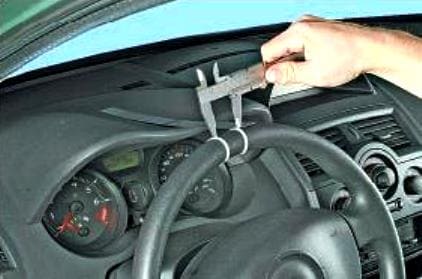
Measure the distance between the marks along the rim. It should not exceed the calculated value.
If the distance (steering wheel free play) is greater, the cause must be found and corrected.
Steering wheel free play 0–30 mm.
Checking the steering column
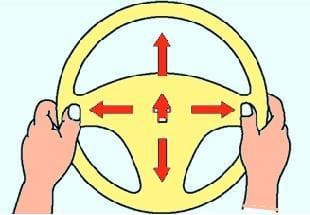
Moving the steering wheel as shown in figure 1, check the wear of the steering column bearing, the free play in the steering shaft joint, the reliability of the fastening of the steering wheel and steering column.
Repair or replace parts as needed.
Checking the force on the steering wheel
Check the following:
- - tire size and tire pressure;
- – fluid level in the hydraulic booster reservoir;
- - tension of the power steering pump drive belt.
Put the vehicle on a firm, level surface with the wheels in a straight-ahead position.
Remove the airbag module.
Be careful when removing the module.
Start the engine and warm up the power steering fluid to 50-60 °C.
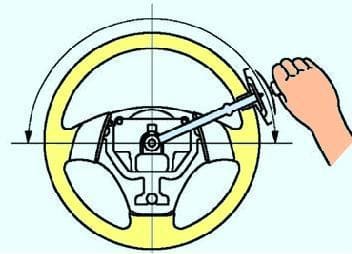
Measure the force on the steering wheel with a torque wrench (fig. 2).
If the force is not correct, check the following:
- – the presence of air in the power steering hydraulic system;
- - leaks through hoses and their connections;
- - the operation of the power steering pump and steering gear. Steering wheel force 7.8 Nm.
To check the steering force, compare it with the steering force of another car of the same model under the same conditions.
The force on the steering wheel depends on the following conditions:
- – pavement condition (dry or wet, asphalt or concrete);
- – tire condition (manufacturer, degree of wear, tire pressure).
Checking the pressure in the power steering circuit
Put the car on a two-post lift.
Remove the engine undertray.
Install a clamp on the power steering pump inlet line to reduce the amount of fluid escaping.
Take care to protect the generator from oil from the power steering system.
Disconnect the wiring harness from the pressure sensor.
Remove the pressure sensor.

Install the manometer fitting instead of the pressure sensor (fig. 3).
Remove the clip.
Lower the car.
Fill oil into the power steering system (elf renault matic d2)
Bleed the system by turning the steering wheel from one end to the other with the engine off.
When removing air from the system, do not hold the steering wheel in the extreme position: this may damage the power steering.
Set the wheels to straight ahead.
Bleed the system by turning the steering wheel from one end to the other while the engine is running.
Top up the oil level in the reservoir.
Remove the right front fender liner and the right front wheel.
Check the pressure developed by the power steering pump with the pressure set to medium the position of the steering wheel and in the absence of influence on it, the pressure value is 5–7 bar.
Check the pressure developed by the power steering pump with the steering wheel turned to the end position, the value is 79-86 bar.
Stop the engine.
Raise the car.
Install a clamp on the power steering pump inlet line to reduce the amount of fluid escaping.
Remove pressure gauge and fitting.
If you have removed the O-rings from the power steering pipe fittings, replace them.
Install the pressure sensor.
Torque tighten the 12 Nm pressure switch.
Connect its connector.
Remove the clip.
Fill oil into the power steering system (elf renault matic d2)
Bleed the system by turning the steering wheel from one end to the other with the engine off.
Set the wheels to straight ahead.
Bleed the system by turning the steering wheel from one end to the other while the engine is running.
Top up the oil level in the reservoir.
Checking the pressure in the electric power steering pump
Put the car on a two-post lift.
Remove the left front wheel and front bumper.
Remove the left front fender liner.
Remove the power steering pump mounting bolts.
Install the clamp on the power steering pump hose.
Remove the bolt securing the high pressure pipe fitting on the power steering electric pump.
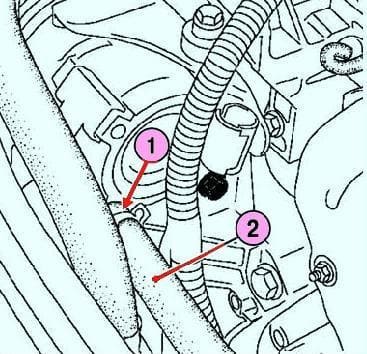
Disconnect the high pressure fuel line from the electric power steering pump (fig. 4).
Connect the hose (Dir1798) to the power steering pump outlet and the power steering pump high pressure outlet.
Install the high pressure pipe fitting and hose bolt (Dir1798) to the power steering pump.
Tighten to 21 Nm the high-pressure pipe fitting on the power steering pump.
Connect the pressure gauge (Mot836-05) to the hose (Dir1798) using the "C" fitting.
Remove the clip.
Lower the car.
Fill oil into the power steering system (elf renault matic d2)
Bleed the system by turning the steering wheel from one end to the other with the engine off.
Bleed the system by turning the steering wheel from one end to the other while the engine is running.
Top up the oil level in the reservoir if necessary.
Check the pressure developed by the electric power steering pump with the steering wheel turned to the end position, the maximum value is 90 bar.
Stop the engine.
Raise the car.
Install the clamp on the power steering pump hose.
Remove the pressure gauge (Mot836-05) and fitting "C".
Remove the hose bolt (Dir1798) and the high pressure pipe fitting on the power steering pump.
Connect the high pressure fuel line connector to the power steering pump.
Install the high pressure pipe fitting bolt on the power steering electric pump.
Tighten to 21 Nm the high-pressure pipe fitting on the power steering pump.
Remove the clip.
Fill oil into the power steering system (elf renault matic d2)
Bleed the system by turning the steering wheel from one end to the other with the engine off.
Bleed the system by turning the steering wheel from one end to the other while the engine is running.
Top up the oil level in the reservoir if necessary.
Check for leaks.
Install:
- - power steering electric pump mounting bolts;
- - left front fender liner;
- - front bumper;
- – left front wheel.
Measurement of car slip on the road
Scheme for checking the car's withdrawal on the road is shown in fig. 5.
Measurement technique
Wrap plastic bag "A" around the steering wheel, securing it to the spoke on the opposite side of the steering wheel.yu withdrawal.
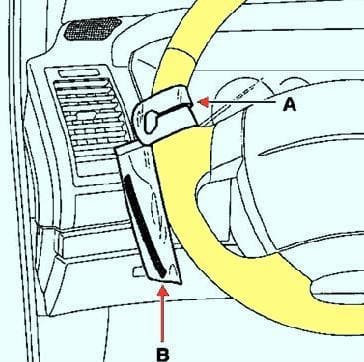
Put as many "B" weights into the bag as necessary to compensate for the pull force (fig. 6).
The amount of pull force corresponds to the mass of weights placed in a plastic bag.








